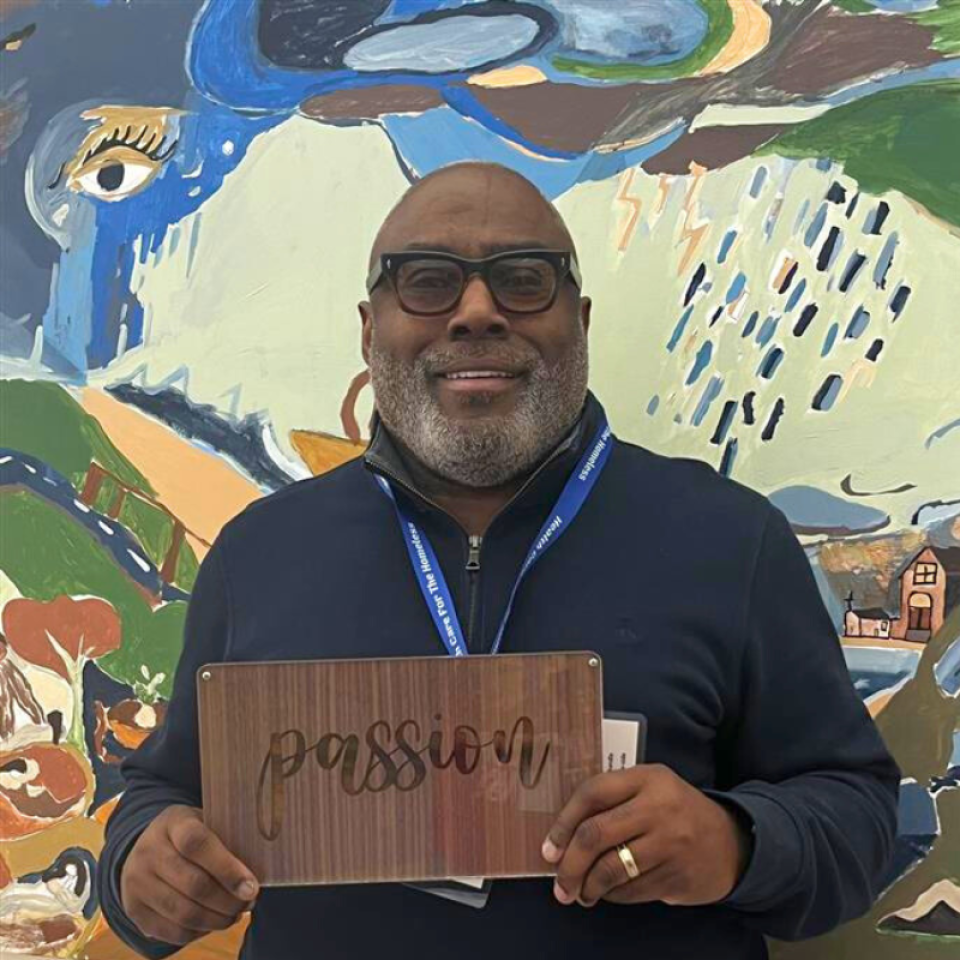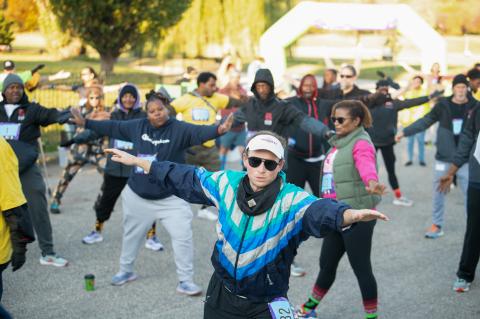
Day in the Life: Community Health Worker
Gregory Rogers is a Senior Community Health Worker (CHW) with years of experience in addiction counseling. A vital part of a client’s care team, CHWs work with clients to navigate care both in the clinic and out in the community.
8:00 AM. It’s early Friday morning, and Greg arrives at the lobby of 421 Fallsway. He greets the clients he recognizes and introduces himself to those he doesn’t, checking in with people to assess their needs while they wait.
One man sits beside an oversized red suitcase. “That’s a bright red sign he might need help finding a bed tonight,” says Greg, before introducing himself.
A few minutes later, Greg jots down his name and number for another client trying to get into Project PLASE, a local shelter; he has contacts at all the local homeless service providers.
Pictured below. Nurse Adam Pfeifer finds Greg to touch base: a client they both work with didn’t make it to treatment last night, and they’re trying to find him. Greg will check the man’s usual spots in the city today.
9:00 AM. Greg moves up to the second floor to greet people waiting for medical appointments or MAT [medication assisted treatment]. “Everybody good this AM?” he calls out, friendly.
Someone in the corner catches his eye. “Good morning, man. Have you been here before?”
They sit and talk quietly. The man has been living at a treatment center for two years and needs permanent housing. “This is the place to be,” says Greg, “because we’ve got MAT, dental, mental health, whatever you need.”
“I’m trying to get straight. I never expected to live this long, to be honest,” he admits.
“Hey, me neither brother,” says Greg. “I know you’re tired. You have to keep building on it. Are you going to meetings?”
Greg helps him look up specific NA groups around the city.
They shake hands and exchange information as Greg gets another call. “There are no shelter beds available right now,” Greg says to the person on the phone. “We can only send people to Baltimore Mission.”
9:45 AM. After checking in with staff around the building, Greg heads to a local food bank. He regularly picks up a few weeks’ groceries at a time for clients who cannot leave their homes. “I don’t like to go home and have food when my clients do not.”
Once at St. Bartholomew’s, Greg waits his turn in line while chatting with church volunteers. “Food insecurity is the biggest need I see right now,” says Greg. The director agrees, citing rising food costs: “We get visitors from 60 different ZIP codes.”
11:20 AM. After Greg’s SUV is filled with groceries, he puts the first address into his GPS. “Today I’ve got one drop-off in West Baltimore, three in East,” he says. “The majority of my clients are undocumented; most are elderly, disabled, or unable to leave the house.”
Pictured below: During one drop-off, Clayvon, who has seen Greg for five years, comes out to meet him: “Hey Mr. Greg!"
12:30 PM. Back at Fallsway, Greg works on case notes and paperwork. “These days I’m working with about 40 clients at a time. Last year I connected with 400 people.”
2:00 PM. MAT Nurse Kathy Pretl calls Greg in for a conference with a client who’s interested in going to inpatient treatment today. As he walks down the hall, he’s already on the phone with a staff member at a local treatment center; they’re on a first-name basis. “If he’s already on suboxone, can we send him to you without detoxing?”
In Kathy’s office, the client, John, is sitting in a chair by her desk. It’s a close fit as they all sit down to talk business.
“I got a few options for you,” he tells John. “I got one place in Dundalk, to start.”
“I don’t want to be stranded somewhere,” John says, nervous. And his main concern is getting transported there. “If they don’t take me right to the door I’ll run away.”
“If you want to get into treatment,” Greg assures him, “we’ll get you there. Don’t worry.”
Greg keeps a mental count of spots at local treatment centers—what beds are available where, each facility’s requirements, what their program is like. Between Kathy, Greg, John, and a rolodex of Greg’s contacts, they negotiate a spot at a nearby center. Kathy gets John a snack while they order an Uber.
“It’s different when it’s your choice to go,” Greg tells him. “Trust me.”
2:30 PM. Greg escorts John downstairs, through the lobby, and out of the building to the Uber. He tells John a staff member will be waiting to meet him at the treatment center.
“You’re the man, Greg.”
“Hey, you’re doing more for me than I am for you,” Greg says. “That’s the most beautiful day to me when someone decides to get treatment.”
3:00 PM. Greg gets back in his car. He drives around, checking on regulars and looking for the client who never arrived to treatment the night before.
“I’m the guy in Baltimore, if a person is missing and can’t be found, I can find them. I can go to any home, any corner, and connect with people.”
“People trust me,” Greg continues. “That's the work of a Community Health Worker—to develop trust.”
Greg is part of the Community Health Worker Coalition, too—advocating for better recognition of CHWs in Maryland. “We need to be supported, and employers need to value us just like they value case workers, social workers, other providers," Greg said at a recent rally.
Read another installment in the "Day in the life" series:
NURSE CARE COORDINATOR HEATHER DOUGLAS
More Recent News
At our annual staff holiday party, we take time to recognize and celebrate staff members who best represent our Core Values, as well as one recipient of the Von Bradshaw Award, named after Delvonia "Von" Bradshaw, who passed away in 2024 and truly held the principles of Health Care for the Homeless to heart. Please congratulate your colleagues when you see them!
Those of us in the Health Care for the Homeless community share a belief in something powerful: that everyone should have a place to call home.
Hope for that vision isn’t passive. It’s something that clients, staff and community supporters make possible together.
With SNAP benefits in Maryland facing uncertainty, many families are wondering how they’ll put food on the table. Here are ways Health Care for the Homeless is helping, as well as a list of local food assistance resources.
On Saturday, November 1, more than 300 runners, walkers, friends and volunteers gathered in Patterson Park for the 2025 Rock Your Socks 5K. Read all about this year's awesome event!




